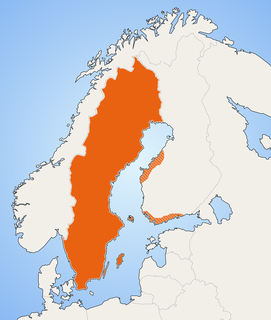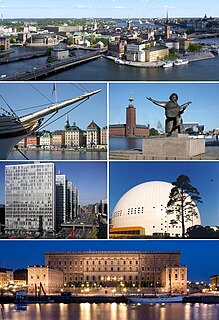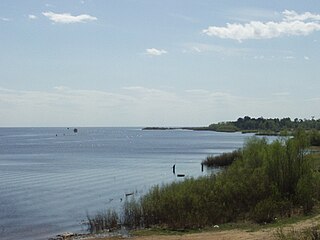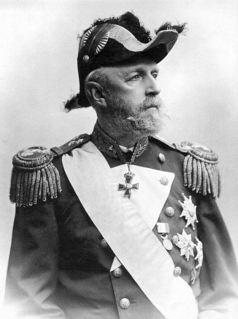
The Dalarna Regiment, designations I 13 and I 13/Fo 53, was a Swedish Army infantry regiment that traced its origins back to the 16th century. The regiment's soldiers were originally recruited from the province of Dalarna, where it was later garrisoned. The unit was disbanded as a result of the disarmament policies set forward in the Defence Act of 2000.

Johan Carl Wilcke was a Swedish physicist.
In Scandinavian folklore, a rå(in Swedish), is a keeper or warden of a particular location or landform. The different species of rå are sometimes distinguished according to the different spheres of nature with which they were connected, such as skogsrå or huldra (forest), sjörå (freshwater) or havsrå (saltwater), and bergsrå (mountains).
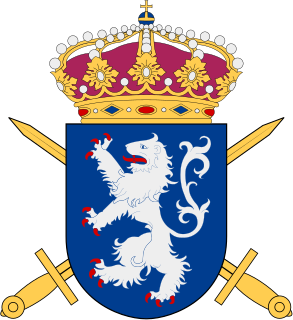
The Halland Regiment, designations I 16 and I 16/Fo 31, was a Swedish Army infantry regiment that traced its origins back to the 16th century. The regiment's soldiers were originally recruited from the provinces of Västergötland and Dalsland, but it was later garrisoned in Halland. The unit was disbanded as a result of the disarmament policies set forward in the Defence Act of 2000.
Hedvig "Hedda" Katarina Hjortsberg also known as Hedda Koersner was a Swedish ballerina who starred for the Royal Swedish Ballet. She was the sister of the Swedish actor Lars Hjortsberg.

Sofia Franziska Stading was a Swedish opera singer of German origin. She is referred to as one of the more notable opera singers in Sweden during the Gustavian era. She was a Hovsångare and member of the Royal Swedish Academy of Music from 1788.
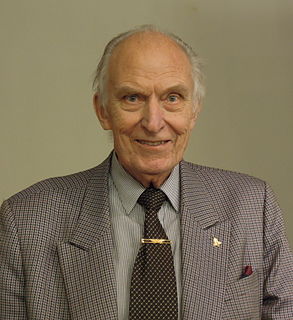
Sven-Olof Olson is a former Swedish Air Force officer. He was Chief of the Air Force from 1982 to 1988.
Sophia Schröder was a Swedish soprano, active as a concert vocalist at the royal orchestra, the Kungliga Hovkapellet, at the royal Swedish court, the first of her gender to have been officially given such a position.
The titles Hovsångare for men and Hovsångerska for women are awarded by the Swedish monarch to a singer who, by their vocal art, has contributed to the international standing of Swedish singing. The formal title was introduced by King Gustav III of Sweden in 1773, with the first recipients being Elisabeth Olin and Carl Stenborg. The position as such, however, dates back to the 17th century, when Anne Chabanceau de La Barre and Joseph Chabanceau de La Barre were singers at the court of Queen Christina of Sweden.

The Bohuslän Regiment, designation I 17, was a Swedish Army infantry regiment that traces its origins back 1661. It was disbanded in 1992. The regiment's soldiers were originally recruited from the provinces of Bohuslän, and it was later garrisoned there in the town Uddevalla.
Gustaf Birger Anders Holm (1845–1910) was a Swedish lawyer and publisher. He worked for the publishing house P.A. Norstedt & Söner, where he became Managing Director in 1879 and Chairman of the Board in 1898.
James Rhea Massengale is an American musicologist and former professor at UCLA, who has specialised in the Swedish poets Carl Michael Bellman and Olof von Dalin. He is a member of the Royal Swedish Academy of Music. He was educated at Yale University, Cambridge University, and Harvard University. He was a professor at UCLA from 1970 to his retirement in 2006.
Caroline Lewenhaupt, was a Swedish courtier, poet and amateur actress.
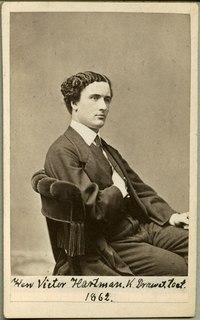
Victor Laurentius Hartman was a Swedish actor.
Royal Swedish Naval Staff College was a Swedish Navy training establishment between 1898 and 1961, providing courses for naval officers. It was the home of the Swedish Navy's staff college, which provided advanced training for officers. It was located within the Stockholm garrison in Stockholm, Sweden.
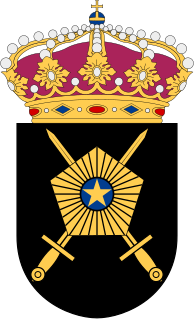
Road and Waterway Construction Service Corps was during the years 1851-2010 a military corps of reserve personnel in the Swedish Army, who was responsible for in the case of war provide the Swedish Armed Forces with specially trained personnel to maintain positions in the field of civil engineering.

Hovjägmästare in Sweden was a court official who supervised the Kungliga Hovjägeristaten at the Royal Court of Sweden and the royal hunting parks. The first hovjägmästare was originally the title of the head of the Kungliga Hovjägeristaten and later the title of any among the hovjägmästare. Today there is a hovjägmästare at the Royal Court of Sweden with the task of assisting in the planning of royal hunts. Hovjägmästare can be translated as Master of the Chase or Master of the Buckhounds and Överhovjägmästare can be translated as Grand Master of the Huntsmen.

Birgit Arrhenius is a Swedish archaeologist and professor emeritus at Stockholm University. She was a professor of laboratory archaeology, and the first head of the university's Archaeological Research Laboratory. Her work has studied places including Helgö and Mälaren, and she has researched prehistoric pressblech and garnet cloisonné work. Arrhenius is a member of the Royal Swedish Academy of Sciences, and was in 1992 the recipient of the Royal Patriotic Society's Gösta Berg Medal.

Coastal Fleet was until 1994 a Swedish Navy authority with the main task of training the naval ships commanders and crews. After the formation of the authority Swedish Armed Forces in 1994, the Coastal Fleet remained as a unit until 2000.

The Västernorrland Regiment, designation I 21/Fo 23, was a Swedish Army infantry unit which operated in various forms the years 1869-1983 and 1991-2000. It was located in Sollefteå Garrison in Sollefteå.
